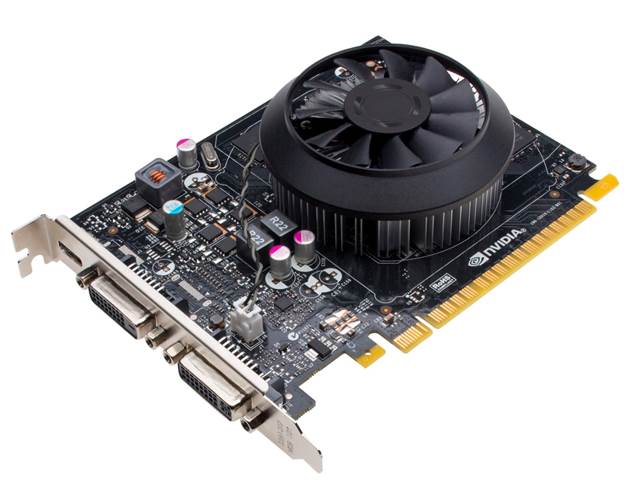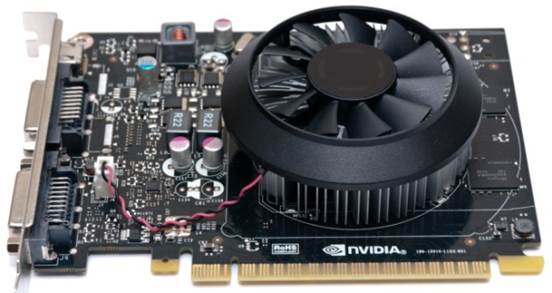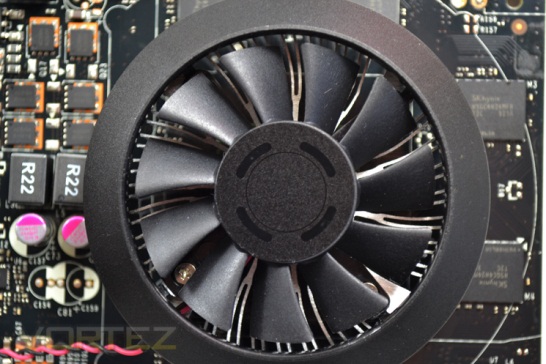Nvidia’s
new Maxwell architecture makes its debut
For the first time, Nvidia is
launching a new GPU architecture in a mass-market product, rather than a
top-end one. The GTX 750 Ti costs $179.23, a fraction more than the Radeon R7
260X and $33.19-41.19 less than the GTX 660 and R9 270. Along with the GTX 750,
it replaces the GTX 650 Ti and GTX 650 Ti Boost in the GeForce product stack.

Nvidia GeForce GTX 750 Ti
The new GPU, GM107, was designed with
mobile products in mind, and performance per watt is Maxwell’s big selling
point. The card has a TDP of just 60W, compared to 115W on AMD’s R7 260X, which
requires a 6-pin PCI-E power connection, while the GTX 750 Ti is powered by the
PCI-E slot alone.
Maxwell is (for now) manufactured on
the same 28nm process as current Kepler cards, so other methods were needed to
boost efficiency. Fundamentally, Maxwell still relies on Graphics Processing
Clusters (GPCs) divided into Streaming Multiprocessors (SMs), but the SMs have
been redesigned.

Nvidia GeForce GTX 750 Ti
In Maxwell, SMs contain 128 stream
processors, compared to 192 in Kepler. Previously, all the stream processors
were shared between a large and complex array of schedulers and dispatch units.
Now, however, they’re divided into four processing blocks of 32 each, and each
block has its own dedicated dispatch and scheduling hardware. This division
allows for smaller and simpler scheduling hardware, which decreases power
consumption.
These scheduling improvements, coupled
with the simpler, more parallel power-of-two layout, improves workload
balancing and core utilisation, so cores spend less time doing nothing but
drawing power. There are also more instructions issued per clock, and fewer
stalls in the pipeline, and Nvidia claims that a Maxwell SM offers around 90
per cent of the performance of the Kepler one, despite consuming less power,
being significantly smaller and having a third of the stream processors.
The L2 cache size has dramatically increased
too. Even in the tiny GM107 chip, it’s 2MB in size, which is even larger than
that of the GK110 GPU in the GTX 780 Ti. This boosts efficiency by reducing
calls to the main video memory. The GPU has two 64-bit memory controllers
connected to 2GB of GDDR5 memory, which is clocked at 5.4GHz (effective) for a
memory bandwidth of 86.4GB/sec. Core clock speed, meanwhile, is at 1,020MHz,
and Boost 2 is also supported. A boost clock of 1,085MHz is quoted, but ours
stayed at 1,150MHz under load Nvidia’s tiny reference card has a basic cooler
on the right-hand side, which effectively makes it a dual-slot card, but
there’s only a single-slot backplate, meaning that we could see true
single-slot third-party cards. The card doesn’t support SLI, however, so you won’t
find a bridge for it.
Fortunately, Nvidia’s G-Sync
technology is supported, provided you opt for a card with a DisplayPort output.
Finally, the on-board video encoder and decoder (which comes with its own
efficiency improvements), brings support for ShadowPlay and streaming to Nvidia
Shield.
Performance
In our standard 1080p tests, the GTX
750 Ti achieves minimum frame rates of 22fps in Battlefield 4 and 23fps in
Crysis 3, which aren’t playable. However, dropping these demanding games to
their next best presets enables the GTX 750 Ti to achieve smoother and playable
minimums of 35fps and 34fps respectively, with minimal sacrifices to visual
quality. In Battlefield 4, this results in performance on a par with the R7
260X, but in Crysis 3, it’s enough to be noticeably smoother than both the R7
260X and GTX 650 Ti, which can’t maintain 30fps.
BioShock Infinite and Skyrim are
easier to run, and the GTX 750 Ti manages smooth frame rates at the best
possible settings at 1080p. Each of the four cards tested is able to do the
same, but the GTX 750 Ti excels in BioShock Infinite, where it’s 25 per cent
quicker than the R7 260X.

Nvidia GeForce GTX 750 Ti
We hit the highest core clock speed
possible in EVGA Precision X when overclocking – 1,155MHz. Under load, the card
consistently boosted to an incredible 1,285MHz. We also overclocked the memory
by 22 per cent to 1.65GHz (6.6GHz effective). These are fantastic overclocks
given the reliance on PCI-E power. At these frequencies, the card surpasses the
GTX 660 in BioShock Infinite and maintains borderline playable frame rates
using Very High settings in Crysis 3.
The power consumption figures really
put everything into perspective. The GTX 750 Ti has the lowest overall system
power consumption, and is especially strong against the R7 260X, which consumes
50W more, despite producing slower frame rates in every benchmark. Better yet,
it’s even more efficient when overclocked, as performance increases far more
than power consumption. The card’s efficiency benefits it elsewhere too – even
with its no-thrills cooler, it remained cool and very quiet throughout testing.
Conclusion
The GeForce GTX 750 Ti isn’t the most
exciting GPU in terms of gaming performance, but you can still expect to play
modern games at 1080p with High settings, which isn’t bad for just $179.23 inc
VAT, although of course, it limits future proofing too. It’s price/performance
ratio is decent enough, but if you can afford it, the R9 270X will perform
better, giving you enough headroom to push all your games to their maximum
settings at 1080p.
Maximum settings aside, however, the
GeForce GTX 750 Ti is easily the fastest card available that doesn’t require an
external PCI-E power connector, and would therefore make a fantastic upgrade
for an aging off-the-shelf PC, or an ultra-small form factor build, without
needing to worry about power draw,. We’re now eagerly waiting to see what the
rest of the Maxwell parts have in store.
|
Specifications
·
Graphics
processor Nvidia: GeForce GTX 750 Tl, 1,020MHz (boosting to 1,085 MHz) ·
Pipeline:
640 stream processors, 16 ROPs ·
Memory:
2GB GDDR5, 5.4 GHz effective ·
Bandwidth:
86.4GB/sec ·
Compatibility:
DirectX11.2, OpenGL 4.4 ·
Outputs/Inputs:
DVI-I, DVI-D, mini-HDMI ·
Power
connections : None ·
Size:
147mm long, dual-slot
|